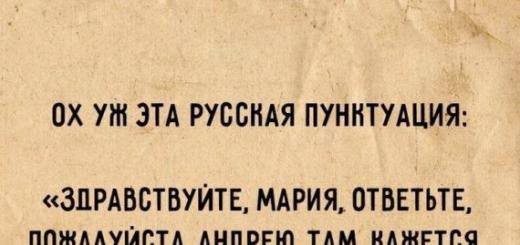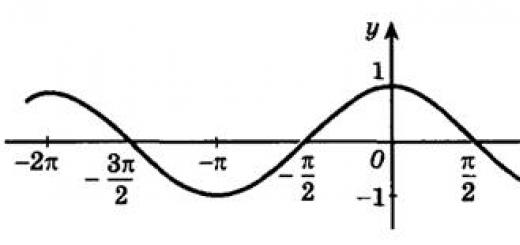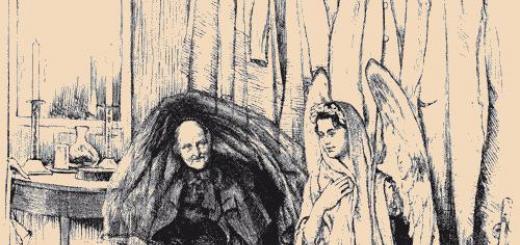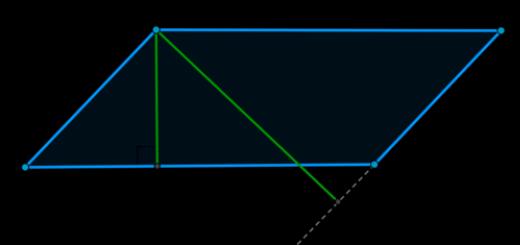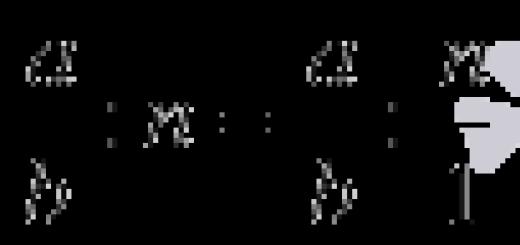Punctuation(from lat. punctum - dot) is a section of the Russian language that studies arrangement of punctuation marks, as well as the punctuation system itself. Punctuation in Russian serves in order to accurately convey in writing what the author wanted to express. Punctuation rules created in order to regulate the intonational structure of speech, as well as syntactic and semantic relations in the language.
We all remember the greatness and power of our language. This refers not only to its lexical richness, but also to its flexibility. This also applies to punctuation - there are both strict rules and guidelines that depend on the situation, style and meaning of the text.
Punctuation in Russian speech achieved through punctuation. Punctuation marks- these are graphic symbols necessary in order to convey the intonation and meaning of the sentence, as well as to place certain accents in speech.
In Russian, there are the following punctuation marks:
1) End-of-sentence signs: dot, question mark and exclamation point;
2) Separation signs of parts of a sentence: comma, dash, colon and semicolon;
3) Signs highlighting individual parts of a sentence: quotes and brackets.
I came home late. Why is the bedroom light still on? So it is, she was waiting for me! "Things at work again?" she asked wearily. The apartment smelled of drugs (probably she drank valerian tincture so as not to worry), so I tried to calm her down and go to bed as soon as possible. All the events of that day flashed before my eyes: a scandal at work; a reprimand from a boss who unfairly accused me of what had happened; walking around the city at night in thought.
Punctuation marks can be repeated and combined. For example, the use of a question mark and an exclamation mark at the same time indicates that we have rhetorical question(a question that does not require an answer or the answer to which everyone already knows):
Who knew that everything would happen like this?!
How long?!
Can also be combined comma with dash. This combination allows you to connect different values:
A cool wind blew, it got dark in the forest - a summer village evening was coming.
This combination of punctuation marks can also be explained by the use of different constructions, for example, the use of a dash between the subject and the predicate in a sentence:
You, brother, are the dearest person that I have left on earth.
Despite the fact that in Russian there are cases when there are no strict rules for the use of certain punctuation marks, even in such cases there are certain recommendations. For example, in such cases there are basic punctuation mark, i.e., the one to which preference is given. For example, the main punctuation mark when using insert structures are brackets:
After yesterday's downpour, we all (except Anna, who happened to have a raincoat) got a cold.
In this case, it is allowed to highlight the plug-in construction using a dash (a secondary punctuation mark in this case):
He sat down thoughtfully on the bench - it was wet from the rain - and thought about what had happened today.
All punctuation and punctuation rules we will look at it in more detail in future articles.
In his oral speech, in order to convey the desired meaning, a person actively uses the appropriate intonation and pauses. They are distinguishing signals between parts of the utterance. Written speech of any language also has similar signals. They are called punctuation marks, they are graphic symbols. In Russian linguistics, there is a whole section that is devoted to the rules for setting signs in writing. This is what punctuation learns.
Why are commas needed?
The term "punctuation mark" is derived from the verb "punctuate", which literally means "stop and delay". And he seems to be doing his job well. For many people, writing becomes a stumbling block. Their incorrect placement or complete disregard, and this also happens, can turn even a well-written text into a useless set of words or phrases. On the other hand, correctly placed signs fill the written text with meaning, facilitate its perception, dividing it into separate fragments and enriching it with emotions.
Why study punctuation? when used skillfully, they help the author to highlight the thought and give the text the right sound. They are also compared to musical notation, which produces beautiful music when played appropriately. Thus, periods and commas help fill the needs of written communication. And this leads to the understanding that it is necessary to study punctuation so that what is written is correctly interpreted by the addressee.
A bit of history
According to some sources, the birth of punctuation occurred in ancient Greece. They mention that the Greeks used some signs for expressive reading - recitation. Nothing more is known about the further fate of these signs. And in the 16th century, punctuation first appeared in European countries, whose origin is associated with the Italian publishers Manutsii. They invented punctuation marks, which are still used unchanged in many languages today.
Russian punctuation, which is studied in our time, acquired its main features as a system of signs by the 18th century. This is directly related to the invention and development of printing. Printers had to present the text in such a way that readers could correctly perceive what they read. It is they who should be given credit for the "invention" or, better to say, the introduction of punctuation in Russia.
Understanding the importance of punctuation marks, or rather attempts to comprehend them, came with the names of L. Zizania and M. Grek. It was extremely difficult to read Old Russian texts, moreover, gaps were not put in those days either. Later M.V. Lomonosov, while developing questions of punctuation, determined that the arrangement of signs in a letter is determined by the structure and semantic aspect of speech. In his theory, he determines the number of signs and their purpose, which gave rise to the whole system.

Punctuation - grammar section
Modern punctuation (the Latin word punctum - dot) is a developed and rather complex system. This is one of the sections of grammar that studies the established rules for placing punctuation marks in writing. Also in this section, the signs themselves are considered, as a special part of the graphic system of the language, for the separation of written speech. The basic rules of punctuation study that there are some patterns in the use of the same character in different cases. The rules are normative in nature, they will be equivalent for all types of writing.
The punctuation unit is represented by a punctogram - a sign that is reproduced in a letter, in accordance with accepted rules and regulations. The entire punctuation alphabet consists of ten punctuation marks. These are period, comma, colon, dash, semicolon, quotation marks, ellipsis, brackets, exclamation mark, and question mark. You may notice that, unlike the traditional alphabetic alphabet, this one has a free listing order. At the same time, some tend to highlight the period and comma as the main punctuation marks.
As has been observed in practice, the signs themselves do not cause much difficulty, but the rules for their placement in the text cause many to stumble. The difficulties that arise indicate that it is necessary to study punctuation in Russian.

Formatting text with signs
Not so long ago, the basis of Russian punctuation was influenced by one-sided views, some separate principle of arranging signs in writing stood out as opposed to others. But now the selected principles form a whole system of using punctuation marks, and any grammatical phenomenon can be shown from different angles.
Basic principles of punctuation:
- Intonation. Here, punctuation marks reflect the intonation of a person's voice, conveying its shades.
- syntax principle. Punctuation marks are placed according to the structure of the sentence, its structure.
- Structural-syntactic. Punctuation marks construct a text or a sentence.
- semantic principle. The design of the text with signs is associated with its semantic division.
Modern punctuation rules take into account the meaning, structure, and intonational articulation of speech.

Punctuation tasks
All punctograms of the Russian language are divided into two groups and perform the tasks assigned to them. The signs will either separate the semantic parts of the text from each other, or highlight certain segments within these parts.
The duties of separating punctuation marks are performed by: dot, comma, semicolon, dash, ellipsis, exclamation and question marks. And paired punctograms cope with the role of the selection function: commas, dashes, quotation marks, brackets. They isolate the necessary words, phrases, phrases or even individual sentences.
In addition to the accepted ones that are studied in Russian, there are many options for the author's arrangement of signs that are not related to the rules. The authors use this approach not only to convey the accuracy of their thoughts, but also to give the writing a special expressiveness and intonation brightness. Therefore, the functional importance of punctuation marks can hardly be overestimated, especially when it comes to complex and voluminous texts.
Punctuation - this is
1) a system of punctuation marks;
2) norms and rules for the use of punctuation marks, historically established in Russian writing;
3) a section of linguistics that studies punctuation marks and the rules for their use in writing.
The main purpose of punctuation is to help the reader understand the written text, its structure, syntactic and semantic. Text written without punctuation marks is read three to five times slower than formal text. (Lecant)
At the heart of the word punctuation lies the root -f-, from which such words as comma, kick, obstacle and others. All these words contain, to one degree or another, the meaning of obstacles, obstacles, conditions, delays. Similarly, punctuation marks coincide with stops in speech, with intonation, with the transition to a new thought, to a new concept.
PUNCTUATION RULE
A punctuation rule is an instruction that specifies the conditions for choosing a punctuation mark (that is, its use or non-use). The conditions for choosing a punctuation mark are the grammatical, semantic and intonational features of sentences and their parts.
Note. The place in the sentence where punctuation is required can be found by identification signs (signs). Identification signs of the application of punctuation rules:
1) morphological: the presence of participles, gerunds, interjections, conjunctions, individual particles;
2) syntactic: the presence of two or more grammatical bases, appeals, introductory words, isolated members of a sentence, homogeneous members, someone else's speech;
3) sound: pronunciation with vocative and other types of intonations;
4) semantic: expression of reason, etc.
(M.T. Baranov, T. Kostyaeva ... A guide to the Russian language for students)
PRINCIPLES OF PUNCTUATION
1. Intonation principle. (L.V. Shcherba, A.M. Peshkovsky, L.A. Bulakhovsky) Punctuation marks are indicators of the rhythm and melody of speech. (Russian punctuation partly reflects intonation: a dot in place of a large drop in voice and a long pause; question and exclamation marks, intonational dashes, in some cases ellipsis, etc.. (...)
The warm wind blowing from the south subsided.
A sharp wind blowing from the west suddenly suddenly verse.
2. Syntactic (grammatical) principle.(Ya. K. Grot) punctuation marks make the syntactic structure of speech clear, highlight individual sentences and their parts. This is reflected in the wording of most of the punctuation rules:
as a dot, fixing the end of a sentence; signs at the junction of parts of a complex sentence (when their delimiting role is meant); signs that highlight various constructions, but are not grammatically related to it, i.e., not being its members (introductory words, combinations of words and sentences; insertions, appeals; interjections); signs with homogeneous members of the sentence; signs that highlight applications, definitions - participial phrases and definitions - adjectives with dependent words, standing directly after the word being defined or torn off from it by other members of the sentence (...)
3. Logical (semantic) principle. Punctuation provides understanding of the text. (But quite often it happens that the semantic articulation of speech subjugates the structural, that is, the concrete sense dictates the only possible structure.
For example: Three in front of the photo, tense(I. Ilf).
The three are tense in front of the photo.
The semantic principle in the arrangement of punctuation marks is revealed especially clearly when isolation, as well as with the connecting members of the sentence (...) The specific semantic shades fixed in a sentence can (...) vary, and therefore in punctuation based on such a principle, there is always something subjective, individual (...)
CONCLUSIONS: all three principles act in it not in isolation, but in unity (...) Separate principles can now be singled out only conditionally, for the convenience of study (...)
Thus, if we take into account that the syntactic units of speech are created in order to convey thoughts and emotions, then the combination of the action of all three principles in a single punctuation system becomes obvious. (Valgina)
Intonation and punctuation are children of the same father - the meaning of speech.
Some cases of inconsistency in intonation and punctuation
1) There is no pause, but there is a comma:
He made several jumps, but, realizing that he could not catch up with them, he fell behind.
It is strange for us to hear that if a person falls ill, he should have money for a doctor.
Upon learning what had happened, they immediately arrived.
Conclusion: writing "by ear" is a source of errors.
2) There is a pause, but there is no comma.
Cut through a centuries-old pine forest, the clearing went far beyond the horizon.
In the fall, the Nazis burned the village for contact with the partisans.
And sailing to other lands on sea water, you will not find another such Russia anywhere.
Punctuation marks and their functions.
11 punctuation marks:
dot (.), question mark (?), exclamation point (!),
ellipsis (...), comma (,), semicolon (;), colon (:),
dash (-), brackets (round) (), quotation marks (" ") paragraph (red line)
ZP functions:
Separator (dot, ?, !, ;, ..., :, red line) - separates text segments from each other
Emphasis (brackets, quotation marks, single dashes and commas)
Any of us at school had to write dictations in our native language. And, probably, the most offensive was the reduction in the final grade due to a missing or extra comma. Let's find out why this symbol and others like it are so important in the language, and what science specializes in this issue.
What does punctuation study?
At the end of the previous sentence there is a well-known to all of us which signals to each reader that this is a question, not a statement. It is on the study of such signal elements that such a science as punctuation concentrates.
Moreover, she specializes not only in the formation and regulation of norms and rules for setting punctuation marks, but also studies their history.
What is it for?
Having learned what punctuation studies, it is worth paying attention to its practical value. After all, for example, the practical meaning of spelling is clear to most of us - if people are not taught to write correctly, it will become unclear to others what they want to say: flight or litter, etc. At the same time, many "victims" of school punctuation repressions are still perplexed : what difference does it make where to put a comma, why is it needed at all, and why a whole science was formed to study it.

Let's figure it out. So, punctuation is important to facilitate the perception of the text. With its help, sentences or their parts are separated from each other. This allows the writer to focus on the thought he needs.
In order to more clearly understand the meaning of punctuation marks, it is worth recalling the "bearded" example from the cartoon "In the country of unlearned lessons" - "You cannot be pardoned".
The life of the protagonist, Vitya Perestukin, depended on where the comma would be placed. If he had put her in this way: "Execute, you can’t pardon" - Vitya would have been threatened with death. Fortunately, the boy correctly endured the sign: "It is impossible to execute, pardon", and thus escaped.
In addition to focusing on certain parts of a sentence, it is punctuation that often helps to understand its meaning.
For example, if you simply put a period at the end of the sentence "Our mother has come", this will be a statement of the fact that the mother has arrived.
If you replace it with a question mark, it will no longer be a statement of a fait accompli, but a question: "Did our mother come?"
Term etymology
Having considered what punctuation studies and why it is needed, we can pay attention to the origin of this concept.
The term under study was derived from the Latin word punctum, which translates as a dot. Based on this, we can assume that the first punctuation mark in history is precisely the period (in any case, this is the case in Russian punctuation).
It is believed that the ancient Greeks were the first to use it as a sign of the end of a sentence or even an entire paragraph.
Punctuation marks
Knowing what punctuation is studying, it is worth dwelling on this in more detail. In other words, let's pay attention to punctuation marks. They are also called punctuation and are elements of writing necessary to achieve such goals.
The main ones are:
- Separation / selection of words, phrases, semantic segments in a sentence or a whole text.
- They point to grammatical and sometimes logical connections between words.
- They indicate the emotional color of the sentence and its communicative type.
- Signal about the completeness / incompleteness of the statement / thought.
Unlike words, punctuation symbols are not members of a sentence, although they perform very important functions in it.
The need for such signs is emphasized by the fact that in most text editors, when checking spelling, punctuation errors are highlighted in a separate color - green, while spelling errors are red.
Types of punctuation marks that are in Russian
To remember exactly which separating characters are used in Russian, it is worth remembering any lesson about punctuation. It necessarily mentioned most of these elements. All of them are divided into two categories: paired and unpaired.
The first ones are much smaller: quotes "", brackets (), 2 commas and 2 dashes.
They serve to highlight a word, phrase or part of a sentence and are always used together, functioning as a whole.
At the same time, quotation marks are also used to highlight names in Cyrillic and as a designation of direct speech.
By the way, the most common mistake in punctuation of paired characters is to forget to put the second of them.
There are much more unpaired punctuation characters. They are divided into groups according to their direct functions. Moreover, some of them are able to perform not one, but two roles at once.

Analyzing the above, you can see that nothing has been said about the apostrophe. However, this symbol refers to spelling, not punctuation. Therefore, it cannot be discussed in this context.
History of Russian punctuation
In the Russian Empire, punctuation as such did not exist until the second half of the 15th century. And only in the 80s began to use the dot.
About 40 years later, commas began to be used in grammar.

The combination of these characters into one (semicolon) happened later. Moreover, checking the punctuation of ancient texts showed that initially it served as a question mark. So if, when reading a document dating from before the 18th century, there is a question mark, we can conclude that the paper is probably a fake.

However, since the 18th century a special symbol was used to designate a question. By the way, in the same period, the exclamation mark began to be used in the empire, which initially signaled surprise, and not an exclamation. That is why it was called "amazing".
The first paired character in the grammar of the Russian language was parentheses, first noted when checking punctuation in a document of 1619.
Dash, quotation marks and dots also appeared only in the 18th century. And one of the first and main popularizers was Nikolai Karamzin.
Unusual punctuation marks that are not used in modern Russian
In addition to the symbols well known to us, there are a number of signs that are not recognized by Russian and many other grammars. If you try to put them in a text editor, you will definitely receive a message about the need to correct punctuation in the sentence.

- Interrobang is a hybrid of question and exclamation marks.
- A rhetorical question mark that looks like a mirror image of the usual character of this kind. It was used in English for only a few decades at the end of the 17th century.
- ironic sign. Outwardly similar to the above, but a little smaller and put at the beginning of the sentence. Originated in 19th century France.
- Love symbol, which is advised to use in greeting cards. It looks like a question mark and its reflection, together forming a heart.
- The consonant symbol looks like two exclamation marks written from the same dot. Symbolizes the expression of good will.
- Confidence sign. It looks like an exclamation mark with a cross.
- Authoritative. It is similar to the previous one, but it is not crossed out by a straight line, but by a league. Used in orders or advice.
- Asterism. It looks like three stars placed in the form of an inverted pyramid. Previously, it served to separate semantic chapters, as well as parts of books, or denoted minor breaks in a long text.
- Exclamation and interrogative commas. Designed for intonational emphasis on words or phrases within a sentence.
Punctuation- this is:
- Punctuation system
- A branch of linguistics that studies punctuation marks and the rules for their use in writing
Punctuation rule
Punctuation rule- this is an instruction that indicates the conditions for choosing a punctuation mark (i.e. its use or non-use). The conditions for choosing a punctuation mark are the grammatical, semantic and intonational features of sentences and their parts.
Note.
The place in the sentence where punctuation is required can be found by identification signs (signs). Identification signs of the application of punctuation rules:
- morphological: the presence of participles, gerunds, interjections, conjunctions, individual particles;
- syntactic: the presence of two or more grammatical bases, appeals, foreign words, isolated members of a sentence, homogeneous members, someone else's speech;
- sound: pronunciation with vocative and other types of intonations;
- semantic: expression of reason, etc.
Functions of punctuation marks
Punctuation marks serve to separate sentences from each other in the text, to separate and highlight semantic segments in a sentence. They are divided into three groups: separating(in the text), separating and excretory(in a sentence).
Separating punctuation marks
These include dot, question mark, exclamation point, ellipsis. They are used:
- to separate each word of the sentence from the next in the text;
- to complete a separate proposal.
Punctuation at the end of a sentence
Rules:
- At the end of the declarative and incentive sentences, a period is put if emotions (feelings) are not additionally expressed in them.
- Question marks are placed at the end of interrogative sentences.
- An exclamation mark is placed at the end of any sentence for the purpose of the statement if a feeling is additionally expressed in them.
- An ellipsis is placed at the end of a sentence if the writer makes a long pause.
Separating punctuation marks
These include comma, semicolon, dash, colon. Dividing punctuation marks serve in a simple sentence to indicate the boundaries between homogeneous members (comma and semicolon), in a complex one - to separate simple sentences that are part of it.
The choice of separating punctuation marks is determined by morphological, syntactic, semantic and intonational conditions.
Emphasis punctuation marks
Emphasizing punctuation marks serve to indicate the boundaries of semantic segments that complicate a simple sentence (addresses, introductory words, phrases, sentences, isolated secondary members), as well as direct speech.
Emphasizing punctuation marks are a comma (two commas); dash (two dashes); Exclamation point; brackets are double; colon and dash used together; double quotes.
The choice of highlighting punctuation marks is determined by syntactic, semantic and intonation conditions.
Cases where a punctuation mark is not put
- Between the subject and the predicate, which is attached by a conjunction how.
- Between homogeneous members connected by single unions and, or.
- Before application if union how used to mean " as».
- After a participial turnover, if it stands before the noun being defined and has no causal meaning.
- Before adverbs formed from adverbs.
- Between simple sentences in a compound sentence with a union and if there is a common member.
- Between homogeneous subordinate clauses connected by a union and.
- Between agreed definitions, if they characterize the subject from different sides.


